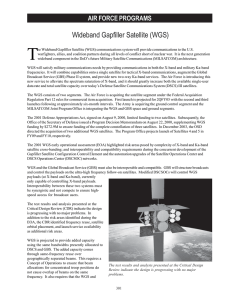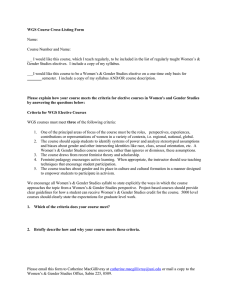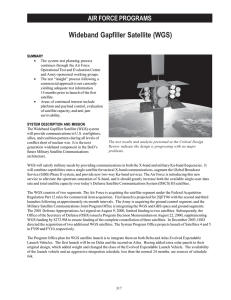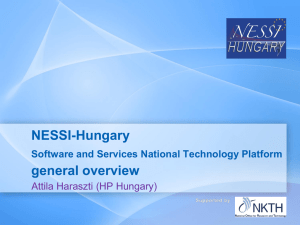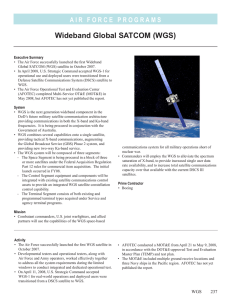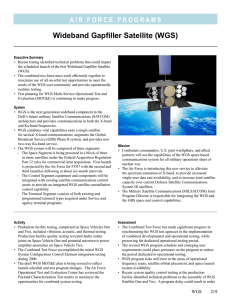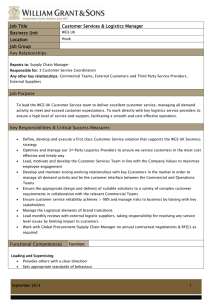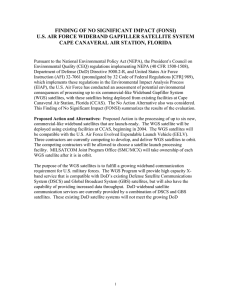Wideband Global SATCOM (WGS)
advertisement
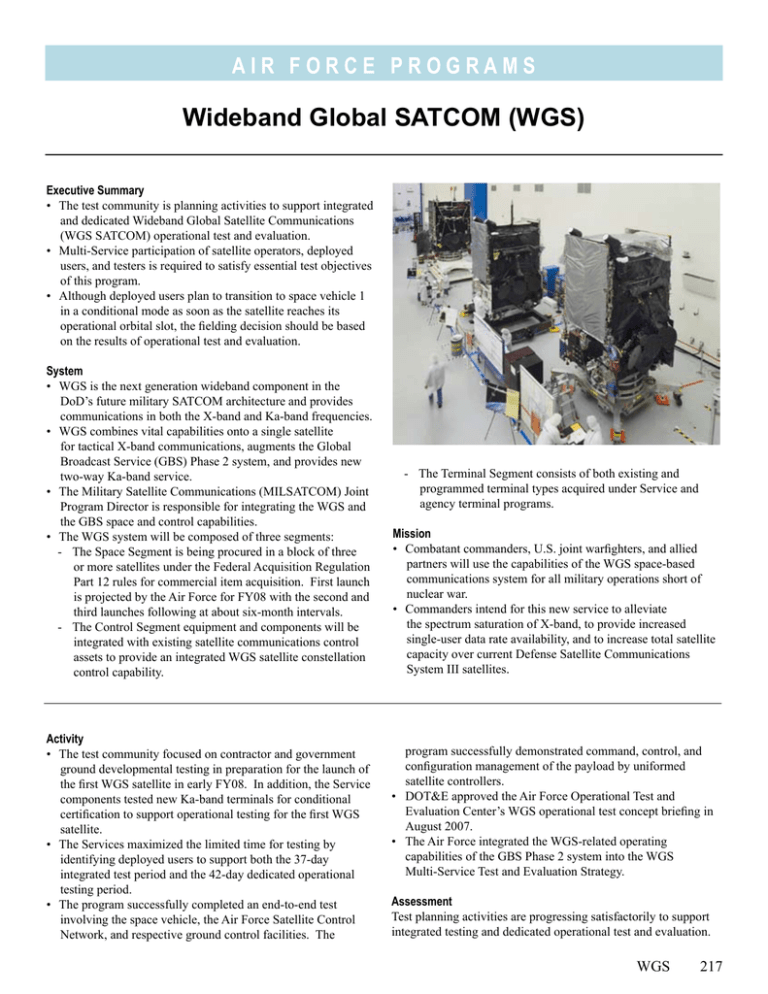
A i r F o r c e P RO G R A M S Wideband Global SATCOM (WGS) Executive Summary • The test community is planning activities to support integrated and dedicated Wideband Global Satellite Communications (WGS SATCOM) operational test and evaluation. • Multi-Service participation of satellite operators, deployed users, and testers is required to satisfy essential test objectives of this program. • Although deployed users plan to transition to space vehicle 1 in a conditional mode as soon as the satellite reaches its operational orbital slot, the fielding decision should be based on the results of operational test and evaluation. System • WGS is the next generation wideband component in the DoD’s future military SATCOM architecture and provides communications in both the X-band and Ka-band frequencies. • WGS combines vital capabilities onto a single satellite for tactical X-band communications, augments the Global Broadcast Service (GBS) Phase 2 system, and provides new two-way Ka-band service. • The Military Satellite Communications (MILSATCOM) Joint Program Director is responsible for integrating the WGS and the GBS space and control capabilities. • The WGS system will be composed of three segments: - The Space Segment is being procured in a block of three or more satellites under the Federal Acquisition Regulation Part 12 rules for commercial item acquisition. First launch is projected by the Air Force for FY08 with the second and third launches following at about six-month intervals. - The Control Segment equipment and components will be integrated with existing satellite communications control assets to provide an integrated WGS satellite constellation control capability. Activity • The test community focused on contractor and government ground developmental testing in preparation for the launch of the first WGS satellite in early FY08. In addition, the Service components tested new Ka-band terminals for conditional certification to support operational testing for the first WGS satellite. • The Services maximized the limited time for testing by identifying deployed users to support both the 37-day integrated test period and the 42-day dedicated operational testing period. • The program successfully completed an end-to-end test involving the space vehicle, the Air Force Satellite Control Network, and respective ground control facilities. The - The Terminal Segment consists of both existing and programmed terminal types acquired under Service and agency terminal programs. Mission • Combatant commanders, U.S. joint warfighters, and allied partners will use the capabilities of the WGS space-based communications system for all military operations short of nuclear war. • Commanders intend for this new service to alleviate the spectrum saturation of X-band, to provide increased single‑user data rate availability, and to increase total satellite capacity over current Defense Satellite Communications System III satellites. program successfully demonstrated command, control, and configuration management of the payload by uniformed satellite controllers. • DOT&E approved the Air Force Operational Test and Evaluation Center’s WGS operational test concept briefing in August 2007. • The Air Force integrated the WGS-related operating capabilities of the GBS Phase 2 system into the WGS Multi‑Service Test and Evaluation Strategy. Assessment Test planning activities are progressing satisfactorily to support integrated testing and dedicated operational test and evaluation. WGS 217 A i r F o r c e P RO G R A M S Recommendations • Status of Previous Recommendations. The Air Force and the Combined Test Force made progress on all three FY05 recommendations; however, two of the three remain valid. The Air Force should continue to carefully control WGS program risks associated with frequency reuse, satellite orbital placement, and launch system availability. The Combined Test Force should maximize the application of combined development and operational testing for WGS, but preserve the previously scheduled test periods needed for dedicated operational testing. • FY07 Recommendations. 1. Developmental and operational testers must work together to maximize the very limited test window while space vehicle 1 is in its temporary check-out orbit. 218 WGS 2. Air Force Space Command and Army Forces Strategic Command must actively participate with satellite operators, deployed users, and testers to satisfy all test objectives of this program. 3. Although deployed users plan to transition to space vehicle 1 in a conditional mode as soon as the satellite reaches its operational orbital slot, Air Force Space Command should base the fielding decision on the results of operational test and evaluation.
